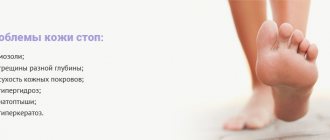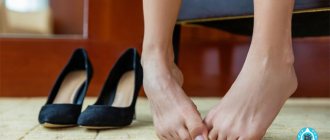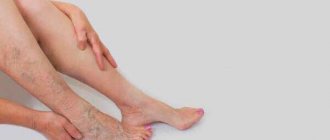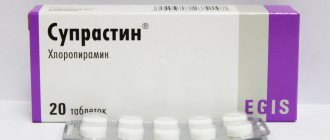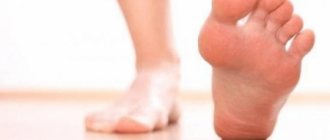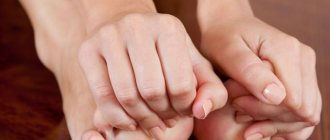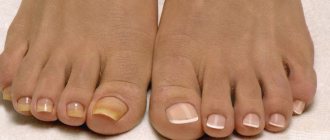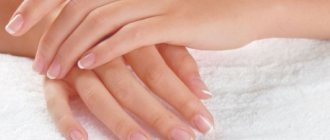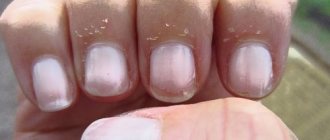First of all, let's clarify the symptoms. Peeling on the fingers or feet means dry skin, the formation of superficial blisters, and lamellar detachment of the skin.
Often, red, “tight” skin is visible under the peeling top layer. As part of self-medication, parents often resort to ointments, which gives a short-term improvement, but within 24 hours the child’s condition worsens again.
As with any symptom, we recommend making an appointment with a dermatologist rather than treating yourself. There are many diseases and ways to treat them.
Similar symptoms give:
- atopic dermatitis; - contact dermatitis; - eczema; - exfoliative keratolysis; - mycosis; - endocrine diseases; - allergic reactions; — lack of vitamins A and E; - incorrectly selected clothes; — violation of hygiene; — fungal diseases; - and many more reasons, with different tactics for their treatment.
Improper care
The skin on children's legs is extremely sensitive to negative influences. Dryness and flaking are often provoked by simply washing your feet with running water. For example, when the water is hard or contains a lot of chlorine. Therefore, after bathing procedures, be sure to apply a moisturizing, nourishing cream or baby oil to your feet. If possible, buy a special filter nozzle for the shower that will retain chlorine and mechanical impurities. This will prevent irritation and protect the baby’s skin from drying out. Prolonged bathing in hot water is also bad.
If the skin of a child's feet is peeling, the reason may be tight, artificial shoes, synthetic tights, or socks. When in contact with such materials, the skin “does not breathe” and sweats, which leads to peeling. The area between the toes is most affected.
Dry air has a negative effect on delicate baby skin. Many mothers notice that it is in winter, when there are hot radiators in the apartment, that the child’s palms and feet become very flaky.
You can solve the problem if:
- use moisturizer daily;
- regularly ventilate the apartment or house;
- maintain humidity within 40 - 60% using a humidifier or improvised means (wet towels, radiator sheets).
For intensive hydration and restoration of children's skin, ointments with provitamin B5 - Bepanten, Dexpanthenol - help.
Allergy
Peeling of the skin on a child’s feet is possible due to allergic reactions, atopic or contact dermatitis.
Irritation is caused by:
- washing powder that you use to wash children's socks or tights;
- baby creams, care oils;
- clothing made from synthetic fabrics;
- highly allergenic foods (citrus fruits, milk, chocolate, eggs, fish);
- insect bites;
- medicines, sweet syrups containing chemical flavors, dyes, flavoring additives.
Allergic reactions are often accompanied by severe itching. Parents should ensure that the child does not scratch the skin, otherwise an infection will occur. Antihistamines help cope with itching, redness, and inflammation. For effective treatment, it is important to identify and eliminate the allergen.
Which foot bath to choose?
The secret of the effectiveness of the baths lies in their natural composition, rich in magnesia and beneficial acids. The product is ideal for relieving fatigue and swelling, reducing inflammation, relieving pain after sports, moisturizing and nourishing the skin, preparing for a pedicure, as well as for people suffering from skin diseases. Epsom offers two foot baths that may interest you:
Foot bath “Foot Pleasure” with mint and lemon essential oil relaxes, relieves swelling and moisturizes the skin of the feet. A cooling bath will soothe discomfort and relieve swelling after sports or high heels, and the invigorating aroma of mint and lemon will instantly lift your spirits.
Epsom salt relaxes muscles, relieves pain and spasms. Salt removes excess fluid, quickly reducing swelling.
Sea salt relieves inflammation, promotes skin regeneration, healing of calluses and small wounds. Baths with sea salt reduce sweating and stop the development of nail fungus.
Lemon and mint essential oil restores tone to the legs, refreshes and relieves fatigue.
Tea tree essential oil has anti-inflammatory and antiseptic properties, improves blood circulation and fights fungus.
Sage essential oil soothes and heals damaged skin.
Macadamia oil nourishes and softens the skin, moisturizes the cuticle and takes care of the delicate skin of the feet.
Epsom Relax foot bath with chamomile and lavender essential oil nourishes the skin, relaxes muscles and relieves nervous tension. A warm evening bath with the aroma of lavender will give your feet lightness and comfort.
Epsom salts soothe muscles and relieve pain and spasms. Salt removes excess fluid, quickly reducing swelling.
Dead Sea salt relieves inflammation, reduces sweating, promotes the healing of small wounds, and effectively fights fungus.
Himalayan salt softens calluses and corns, accelerates skin regeneration, and tones.
Lavender essential oil soothes the skin and nervous system, helps you relax and fall asleep faster.
Tea tree essential oil has anti-inflammatory and antiseptic properties, improves blood circulation and fights fungus.
Chamomile extract relieves irritation and itching, soothes the skin after insect bites.
Macadamia oil nourishes and softens the skin, moisturizes the cuticle and takes care of the delicate skin of the feet.
Fungal infection
If your child likes to try on other people's shoes, walks barefoot in public places or goes to the pool, there is a risk that he has contracted a fungus.
In addition to peeling, this infection is characterized by the following changes in the affected area:
- itching;
- redness, inflammation;
- unpleasant odor;
- thickening of the skin;
- formation of microcracks.
It often happens that peeling is the only symptom. Parents may not suspect that it is a fungus. The skin between the toes usually suffers first, and then, if left untreated, the infection progresses.
To combat the fungus, antifungal agents are used, which are recommended by a dermatologist, mycologist or podologist. The sooner treatment is started, the easier and faster it is to get rid of the infection.
Impact of temperatures
During the cold season, the skin on the toes may peel off as a result of frostbite. After all, children often walk in the cold streets “until they are blue in the face.” They do not feel at all that their feet are wet and frozen. First of all, parents should assess the degree of frostbite. The child may need medical attention. Under no circumstances should you rub the affected areas with snow: there may be microcracks in the skin through which infection can enter the body. Try warming your baby's limbs in warm water, gradually increasing its temperature. With minor frostbite, the skin should turn pink and begin to tingle. To quickly restore the skin, experts recommend lubricating the affected area with Panthenol.
Lack of vitamins
A deficiency of vitamins A, E and D leads to flaky feet in a child. Children under 5 years of age experience this more often than older children.
To tidy up your skin, adjust your baby's nutrition. Add freshly squeezed carrot, apple juice, nuts, vegetable oils, dairy products. If the skin on the feet and legs of an infant is peeling, the nursing mother should reconsider her diet. For bottle-fed babies, the pediatrician decides in what form it is best to add the missing vitamins. Vitamin complexes from a pharmacy are safe to give only as prescribed by a doctor.
If you have hypovitaminosis, you can try applying vitamins topically, directly to problem areas. To do this, take Aevit capsules, add their contents to a small amount of baby cream, and lubricate your feet after bathing. From pharmaceutical products, dermatologists prescribe Radevit ointment, which contains vitamins A, D, E.
Fungus
Why does my child have peeling skin on his feet? The causes and treatment should be determined by a doctor. Often this symptom occurs due to a fungal infection. To avoid this problem, teach your child to follow the rules of personal hygiene. The child should not use other people's towels and shoes.
Treatment of foot fungus is a rather complex process that should be carried out under the supervision of a dermatologist. To determine the pathogen, it is necessary to undergo tests. If the skin peels off in winter, it is necessary to provide it with “breathing”. It is better if the baby walks barefoot or in slippers at home.
Intestinal disorders
The cause of peeling skin on a child's feet is often associated with dysbacteriosis and helminthic infestation. Dysbacteriosis makes it difficult to digest food, and the absorption of vitamins and other substances beneficial to the skin deteriorates. Violation of the intestinal microflora often occurs in infants whose digestive system is not yet fully developed, and in children who have taken antibacterial agents. Probiotics and prebiotics help restore the balance of beneficial and harmful bacteria.
If your feet have been peeling for a long time, it won’t hurt to get tested for helminths. Damage to the body by these parasites negatively affects the condition of the skin, provokes dysbacteriosis, allergies, decreased immunity, and other disorders.
Skin diseases
Skin problems on the legs can be the result of dermatological diseases or infections.
These include:
- Eczema. A hereditary chronic disease, the development of which is provoked by allergies, reduced immunity, stress, and infections. With eczema on the feet, the skin becomes very dry, itchy, red, and covered in a rash;
- Psoriasis. Chronic non-contagious disease with genetic predisposition. The impetus for the appearance of symptoms can be a change of season, rubbing the skin with clothing, infections, or certain medications. Psoriasis causes scaly, inflamed red patches;
- Lichen. An infectious disease caused by various fungal or viral pathogens. There are 5 types of lichen. Ringworm (microsporia) is usually found in children. Children of preschool age and primary schoolchildren who come into contact with street cats or dogs get sick more often. This type of lichen appears as pink spots with a flaky center.
What to do?
Have you noticed that your child's feet are flaky? Don't rush to the moms' forum for advice. If the condition does not improve after using moisturizing baby cream, consult a doctor. Parents' independent conclusions about the cause of skin changes are often erroneous. And lost time and improper treatment only worsen the situation, leading to cracks and infection. Therefore, be sure to consult a dermatologist.
To prevent peeling, make sure your child has:
- complete balanced nutrition;
- moisturizing foot cream with natural composition;
- strong immunity;
- proper foot hygiene;
- comfortable, natural shoes.
To monitor the condition and prevent foot diseases, we recommend that you and your child undergo periodic examinations by a podiatrist and undergo medical pedicures.
0 0
How to get rid of rough skin at home
You can entrust the removal of rough skin to a professional or do it yourself at home. In the second case, you will need the following tools:
- Abrasive file for feet : roller or standard fine-grained grater.
- Scrub : We recommend natural salt-based scrubs, as they have an anti-inflammatory and restorative effect, while simultaneously cleansing and softening the skin.
- Moisturizing or nourishing foot cream : pay attention to products with aloe, panthenol, shea butter and shea butter.
- Foot bath : salt and oils in the bath take care of the skin, relieve fatigue and swelling, promote the healing of calluses, and also prepare the feet for exfoliation.
- Moisturizing socks or foot mask : an optional but very pleasant foot care product that moisturizes and softens calluses.
To summarize, we can distinguish 5 main stages of caring for rough skin on the feet.
